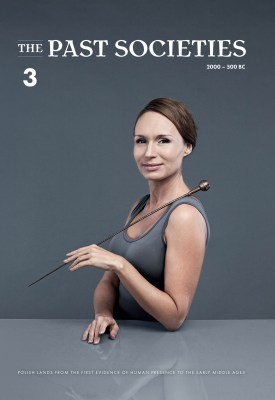 The Past Siocieties T 3, 2000-500BC
The Past Siocieties T 3, 2000-500BC
The Past Societies 3
Informacje bibliograficzne
Istnieje również możliwość zakupu wersji cyfrowej w iBooks Store
Tytuł: The Past Societies 3. Polish lands from the first evidence of human presence to the Early Middle Ages: 2000-500 BC
Redaktor tomu: Urszula Bugaj
Wydawca: Instytut Archeologii i Etnologii PAN
Miejsce: Warszawa
Rok wydania: 2017
Język: angielski
Liczba stron: 386
Format: A4
Okładka: twarda
ISBN: 978-83-63760-97-7
Opis
As far as Polish archaeology is concerned, the time has clearly come for preparing such a synthesis, since the previous work of this kind (Prahistoria ziem polskich l-V) was published over 25 years ago. The new discoveries, new interpretations, and new research approaches developed by the new generation of scholars studying the material remains of the past urgently require a proper synopsis. [...]
The present volumes are the work of 60 authors formally divided into five teams. In order to curb the "separatist" effects of the traditional systematization of prehistory and protohistory (into the Palaeolithic Era, the Mesolithic Era, the Neolithic Era, the Bronze Age, the Iron Age, and the Early Middle Ages), we employed a strictly chronological criterion: volume one encompasses the period between ca. 500,000 BC and 5,500 BC; volume two - between 5,500 BC and 2,000 BC; volume three - between 2,000 BC and 500 BC; volume four - between 500 BC and 500 AD; and volume five - between 500 AD and 1000 AD. Such an artificial division mitigates the sharpness of the traditional "pivotal moments" and at the same time emphasizes the accelerating nature of socio-cultural changes. [...]
Spis treści
Chapter 1 - The Bronze Age
Sławomir Kadrow
Introduction
Bibliography
Chapter 2 - Únětice metal finds from western Poland: an archaeometallurgical perspective
Urszula Bugaj, Krzysztof Nejbert, Sławomir Ilnicki, Piotr Wieciński, Tomasz Onyszczuk, Halina Garbacz
Introduction
1. The context - copper alloys in Early Bronze Age central Europe
2. Archaeometallurgical study - a general introduction
3. Distribution patterns of trace elements in provenance studies - a type of copper ore
4. Metallography - technology and material properties
5. A closer look at some microstructures
6. Final remarks - against technological determinism
Bibliography
Chapter 3 - Małopolska at the beginning of the Bronze Age (2000-1600 BC)
Piotr Włodarczak
Introduction
1. The environment and its regions
2. Dating
3. Settlement patterns
4. Fortified sites
5. Dwellings and the characteristics of settlements
6. Crop cultivation and animal husbandry
7. The emergence of large necropolises
8. Other cemeteries
9. The idea of the barrow
10. Burials
11. The origins of the funerary customs
12. The question of metallurgy
13. The acquisition of salt
14. Mining and the distribution of siliceous rocks
15. Faience production
16. Ceramics
17. Chronological questions and cultural diversity
18. The organization of groups
Bibliography
Chapter 4 - The Trzciniec culture. On the periphery of Bronze Age civilization (1800-1100 BC)
Jacek Górski
1. The Old World of different speeds
2. The starting point. The ingredients of the Trzciniec melting pot
3. Heading south
4. Influence from the south. A movement of people or the circulation of ideas?
5. In the world of rituals
6. At the time of the Trzciniec-Lusatian cultural changes 123 Bibliography
Chapter 5 - The birth of a new world. Barrows, warriors, and metallurgists (1600-1200/1100 BC)
Przemysław Makarowicz
Introduction
1. The origins of the phenomenon
2. Tumulus culture in the Odra and Warta/Noteć interfluve
3. Barrow landscapes
4. Cemeteries and flat graves
Burial customs of the Silesian-Greater Polish Tumulus culture communities - conclusions
Metallurgy and social structure
The Silesian-Greater Polish Tumulus culture: a summary
Appendices
Górzyca. An elite necropolis on the middle Odra
Karczyn - a small family burial ground?
Smoszew - a burial mound at Wał Krotoszyński
Szczepidło - a settlement of metallurgists on the Warta river
Bibliography
Chapter 6 - The formation and breakdown of the Carpathian social networks - a discussion on the archaeological record from the Bronze Age Upper Vistula river.
Marcin S. Przybyła
1. Social networks in the Bronze Age - a few theoretical assumptions
2. Time and research units
3. Routes through the Carpathian Mountains ca. 1600 BC
4. The 'corridor of communication' near the Tisa river between 1700 and 1400 BC
5. The beginning of the Middle Bronze Age in the north of the western Carpathians
6. In search of universal factors regulating occupancy
7. The stabilization of communication via Carpathian Basins in the Middle Bronze Age
8. The regional foundation for the transformation of the network of connections in the Urnfield culture period - I
9. The regional foundation for the transformation of the network of connections in the Urnfield culture period - II
10. Transformations in the network of connections across the Carpathians after ca. 1200 BC
11. Foreign types of ceramics, salt, and multi-culturality in the Kraków region in the Late Bronze Age
12. The population and economy at the end of the Late Bronze Age (950-600 BC)
13. The end of the 'Long Age of Bronze'
14. The networks of connections across the Carpathians - models and transformations
Appendices
A commentary to the methodology of quantitative analyses
Bibliography
Chapter 7 - The Snares of Ostensible Homogeneity. Lusatian Culture or Lusatian Urnfields?
Maciej Kaczmarek
1. The past's research perspectives: Lusatian culture
2. The modern research perspective - Lusatian urnfields as a part of the 'Urnfield world'
Bibliography
Chapter 8 - Late Bronze and Early Iron Age communities in the northern part of the Polish Lowland (1000-500 BC)
Karol Dzięgielewski
Introduction
The awakening of the Baltic region, or how the North was won
Settlements, necropolises, rituals...
The foundations of the Late Bronze Age economy
Society
All about amber?
Appendices
Pomeranian face urns
Bibliography
Chapter 9 - The rise and fall of Biskupin and its counterparts
Karol Dzięgielewski
Introduction
How to settle down by the lake
Society
Biskupin-type strongholds: their times and significance
Bibliography
Chapter 10 - The Hallstatt Period in Śląsk
Justyna Baron
Introduction
Open settlements
Fortified settlements
Scythian finds in Śląsk
Graves
Conclusions
Bibliography


